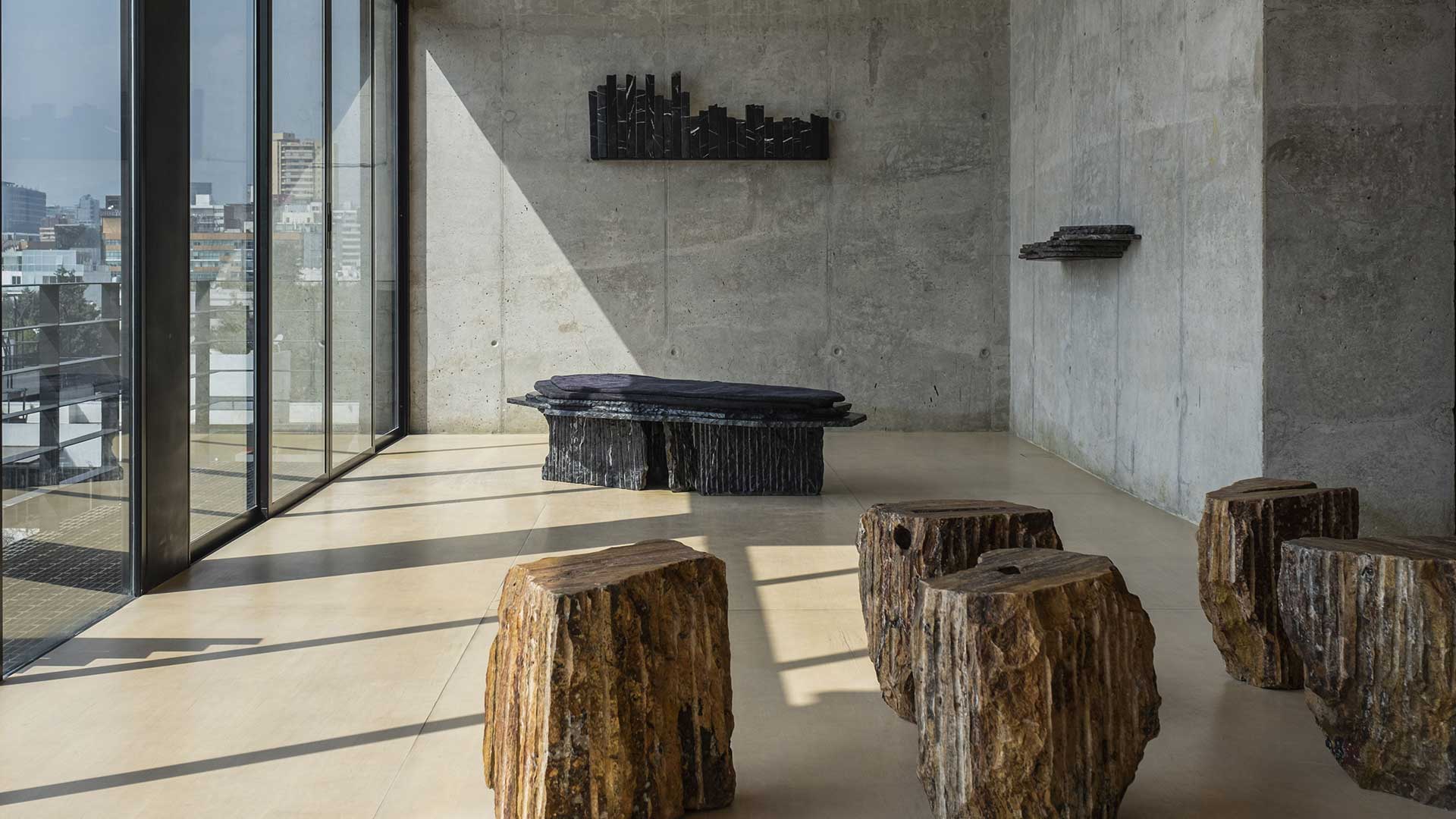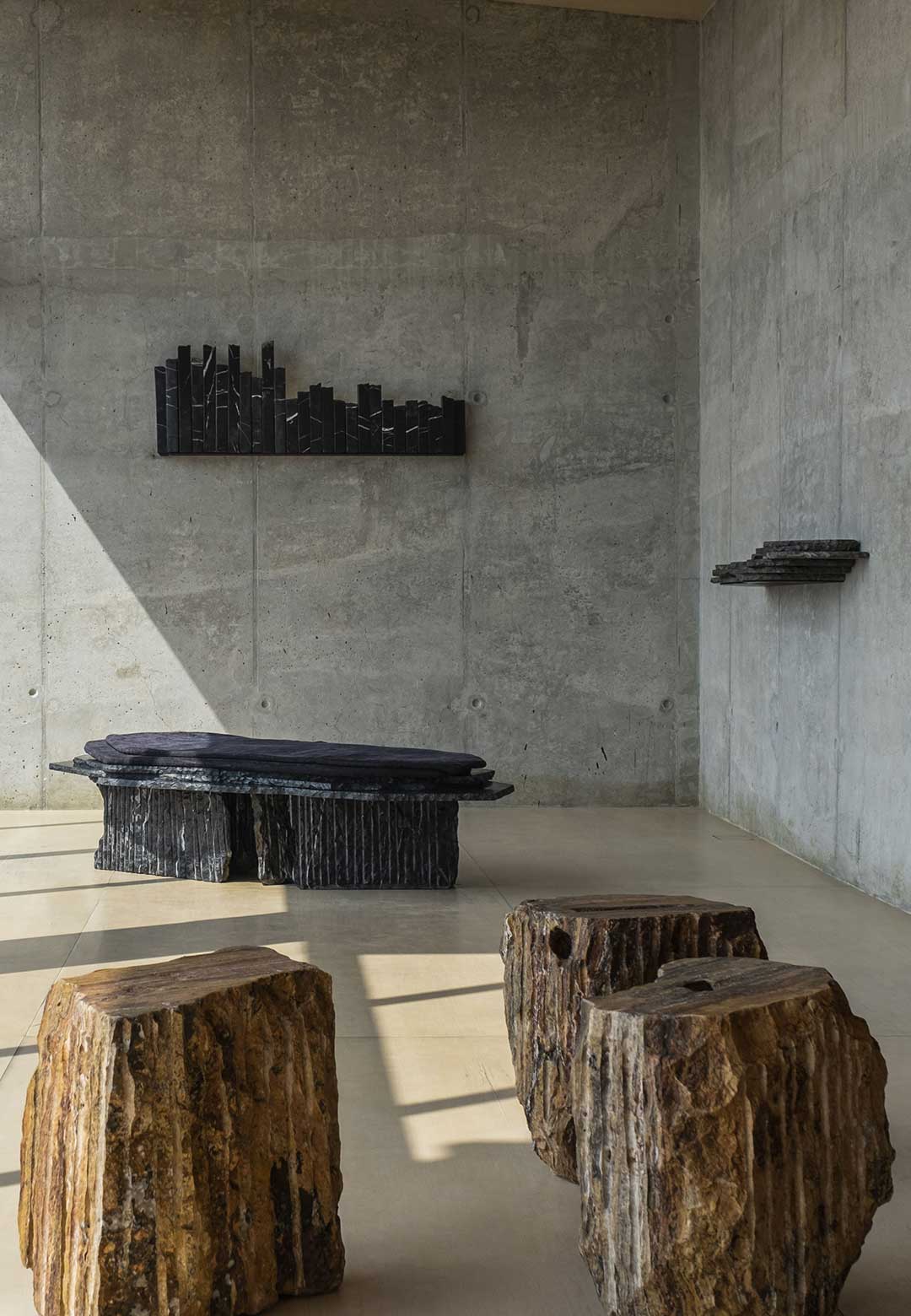Rocks and stones, whether present in their raw forms or chiselled into perfectly cinctured sculptures, are tangible reminders of our most primal instincts. Unlike oceans and seas, valleys and mountains, waterfalls and forests, all of which are anchored in place and are impossible to dislocate, stones and rocks can be picked up and carried outside their place of being. They can be arranged as desired, to decorate, to fortify, to serve as usable furniture or crockery, or to simply exist with their distinct energies. An ongoing exhibition at the Mexico location of Galerie Philia, titled Antipodes, delves into the exploration of this material, as a portal to ruminatory experiences, through the works of Mexican sculpture artist Andrés Monnier and Argentinean artist and creative director Pilar Zeta.
Antipodes means 'the direct opposite of something'. In using this word as the title of the exhibition, the show highlights the contrasts apparent in the textures, appearances and energies of different rocks, as well the distinct characteristics of works crafted by Monnier and Zeta. While Monnier’s Pyrus installation is raw and bears semblance to the rough aesthetic of structures built by our ancestors, Pilar’s well-structured 3D compositions reflect the scope of human perfection. “For this exhibition, we show the contrast between two minds, worlds, universes, two proposals of bodies of work, linked by one common thing: rock. The affinity of choosing rocks as a material for our human world is the link we have with ancient cultures. The appreciation and malleability of rocks are present in human evolution,” the art and design gallery shares. The exhibition opened to the public on February 9, 2023, during the Zona Maco Design Fair in Mexico City, and will remain on display until April 2023.
While we often ponder on the evolution of stone as a raw material for sculptures, furniture, and habitable spaces, and the role and scope of the human hand and mind in transforming them into entities that can fit in myriad spaces and perform varied functions, the impact of stones and rocks on the human psyche is seldom dwelled upon. “Stones are solid and heavy. The weight of the rock is the weight of what we call time. Rocks are not just composed of minerals and particles, rocks have energy. They hide truths and myths within their textures, shapes, colours and porosity. In nature, stones can be found in many formats, from delicate textures to a raw and brutalist surface,” Galerie Philia enunciates, hence inviting us to think about the influence of heavy natural materials—such as stone—on their proximal environments and the beings residing in it.
While Pilar’s installations feature smooth surfaces and soft textures that are physical manifestations of the artist’s thoughts, Monnier’s work alludes to the philosophy of wabi-sabi—it discards the idea of perfection, and exists, like a natural being, in the spaces of the gallery. The juxtaposition of the perfect and imperfect, the carefully shaped and the organically cast sculptures helps create a dissonant environment, which kindles introspection, beyond the usual narratives that surround the showcase of sculptural art. It also enunciates the archaic synergy that humans and rocks share.
Pilar Zeta’s Doors of Perception were initially created digitally and were then materialised in rock. They are based on the idea that our subconscious is guided by energies and symbols from the outside. Her installation is shaped like a door, a portal, an entrance to superior levels of perception, and hence, a passage that leads one to discover novel ideas and realities. In addition to her artistic presentations, Zeta also presents some of her latest furniture at the exhibition.
Andrés Monnier’s installations, on the other hand, are rough and organically shaped. Monnier claims that he does not create anything. Instead, he lets his mind and body be guided by cosmic lines of knowledge to create objects and installations that bear allegories to natural themes. “Just as our perception of reality, our mind, and our human world, a rock can be transformed with the right tools, pulse, and techniques. Antipodes is born from the idea of questioning the perception we have about time and existence. We, humans, are a race, like many others, living on a floating rock that is spinning around on what we call space and time. Rock is a material that has been present in human history since the primitive and prehistoric ages. Do we know the impact that has on our constitution?” Monnier asks.
Monnier’s Pyrus installation comprises a rock pyramid that the artist chiselled himself. The pyramid, apart from alluding to the literal pyramids and the primitive architecture of Mesoamerica, also reminds us of the links—now forgotten—that connect us to our ancestors. The gallery shares, “The rock pyramid serves as an allusion to our ancestors and the collective amnesia we all are part of by forgetting where we come from. In doing so, a series of invitations to question the way we perceive reality and how we are leading our human world are made. The Pyrus installation invites us to connect with our genesis, to primitiveness and the origins of our world.”
Galerie Philia’s Antipodes exhibition, is hence an exploration of a material, the existence of which also starkly contrasts the lives of humans. While humans, made up of mind and matter passed down through generations, attempt to endlessly pursue the idea of immortality, and its possibility, a rock forms little by little, over the years. The former’s lifetime is nothing in comparison to the latter’s. This contrast between our transient existence and a rock’s perpetual existence comes alive in the gallery’s spaces, urging hence the realisation of our impermanence.
Antipodes is on display from February 9, 2023, to April 2023 at Galerie Philia, Mexico.






 Sign in with email
Sign in with email










What do you think?